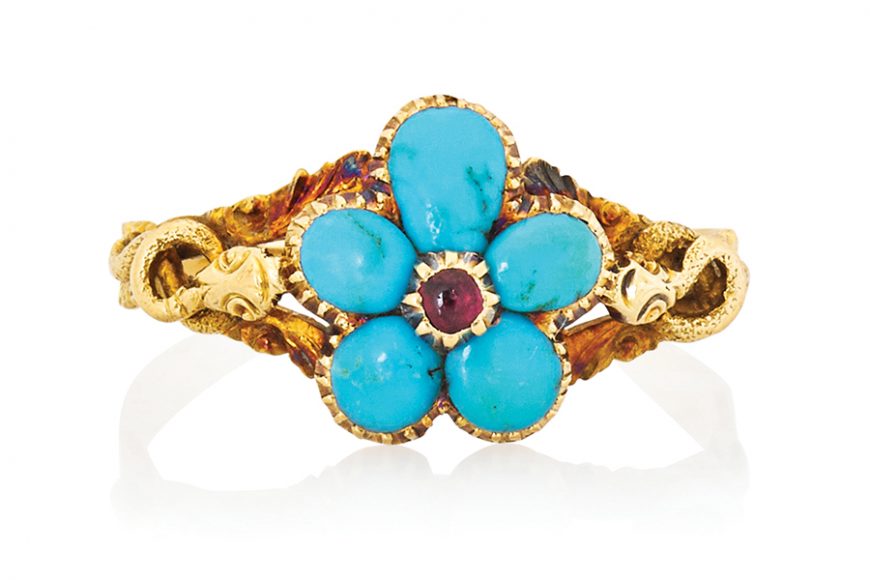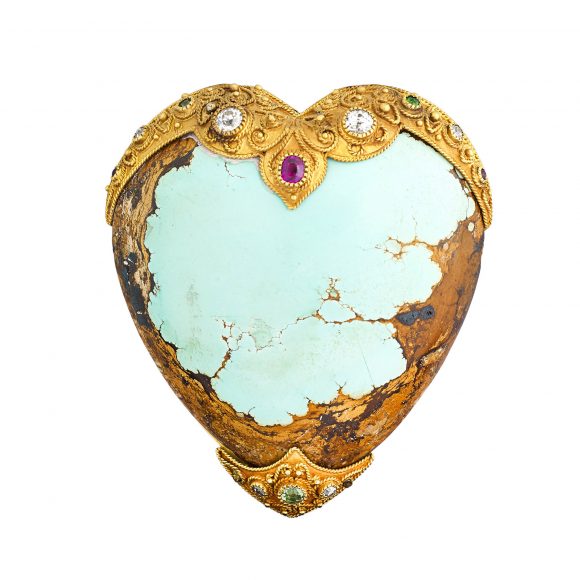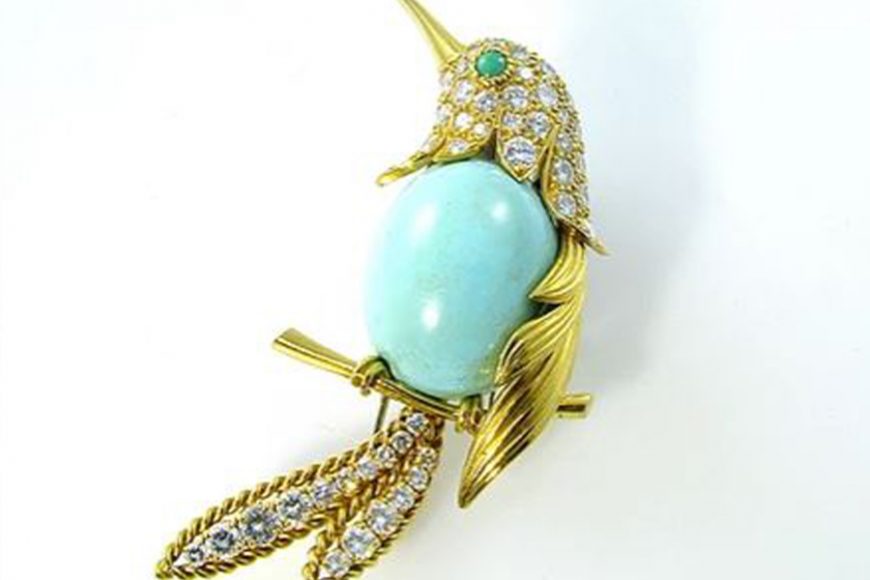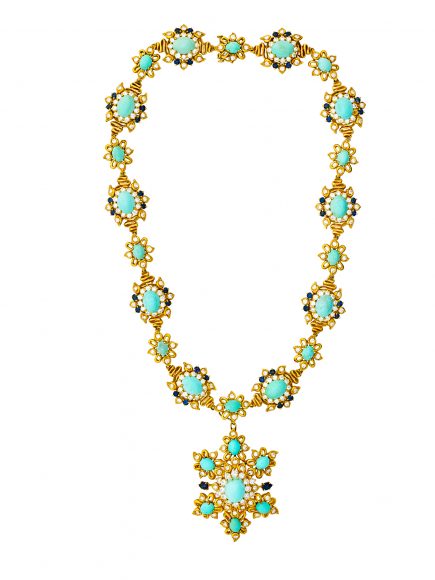“Turquoise is becoming on everyone. It lights up the face.”
So said American jeweler David Webb about one of his favorite gemstones. It certainly is the classic summer accessory, the color of the summer sky, along with the shade of Tiffany & Co.’s iconic blue box. But while we most often associate turquoise with the jewelry of the American Southwest, it actually has a much broader history that spans the globe.
The word “turquoise”, which has come to refer to a color itself, derives from the French turqueise, meaning Turkish — the region through which the mineral traveled to Europe from the Middle East. Turquoise is found in only a few arid regions, such as Iran, the Sinai, China and the American Southwest, where water trickles through host rock, depositing copper, aluminum and zinc. The copper determines the color of turquoise, which can range from pale blue to dark green. Other materials in the host rock form a matrix, creating the desirable spider webs or blotches of black, brown and yellow color. The color, texture and matrix determine the value of turquoise and the most prized and valuable color of all is an even and intense robin’s egg or sky blue. The finest turquoise is referred to as “Persian blue,” referencing the region where the mineral has been mined for more than 2,000 years. The term is used regardless of where it is actually mined.
The first recorded use of turquoise is in Egypt, where the stone was thought to have protective powers. Mined from the Sinai region, turquoise was used in jewelry, amulets and beads and entombed as early as 5000 B.C. It was even used in Tutankhamun’s legendary gold death mask. Turquoise was also used extensively in Persian, Asian and Mesoamerican cultures.
In the West, turquoise became highly fashionable during the Victorian era. (Remember the coveted turquoise ring that Aunt March bestows on spoiled Amy in Louisa May Alcott’s 1868-69 novel “Little Women”?) It was typically cut as round or oval cabochons and was devoid of matrix. In an era known for great sentimentality and symbolism, turquoise was often fashioned as forget-me-not flowers in rings, bracelets and brooches. The simple five-petaled flower conveyed eternal love, remembrance and faithfulness for a departed loved one and was also used to express romantic love. Swallow or dove brooches were often pavé-set with turquoise. The swallow symbolized faithfulness in the safe return of a loved one, while the dove signified peace, friendship and hope.
One of the most dramatic uses of turquoise was in the studded scales of serpent necklaces or coiled bracelets. In 1840, Queen Victoria received a snake-form engagement ring from Prince Albert, spurring a fashion for the motif. The serpent symbolized everlasting love and wisdom. As the Victorian era ended, there was a renewed fashion for turquoise, this time in the Egyptian style. This was likely spurred on by the French stage actress Sarah Bernhardt in her role as an elaborately costumed Cleopatra in 1890.
In the United States, the taste for turquoise was propelled by the development of turquoise mines in the Southwest in the 1880s, leading to a boom and subsequent bust in turquoise production. Turquoise was promoted by Tiffany & Co.’s renowned gemologist George F. Kunz as “gem quality,” and the firm is said to have acquired $2 million of the stone during boom times. Tiffany & Co. incorporated many gemstones of American origin, including turquoise, into its jewelry and silver. Some of its most exceptional pieces were displayed at the 1900 Paris Exposition, including a turquoise and diamond tiara and a series of silver bowls inset with turquoise based on Native American baskets and pottery.
It was in the postwar era that turquoise became fashionable for both daytime and evening jewelry. In the 1950s and ’60s, turquoise was used extensively with yellow gold in spiral, corded or torsade designs for bracelets, necklaces and brooches to be worn during the day. Often the palette was monochromatic, complemented by sapphires or lapis, with diamond accents.
Animal-form pins made extensive use of turquoise and were produced by Van Cleef & Arpels and Tiffany & Co., among others. In the 1950s, Van Cleef & Arpels designed a modestly priced collection of gold- and gem-set birds and other animals that became highly collectible. Donald Claflin’s designs for Tiffany & Co. depicted whimsical animals and characters from nursery rhymes and fairy tales.
Jean Schlumberger, the genius designer who also worked for Tiffany & Co., used turquoise in combination with the subtle green of peridot to a particularly elegant effect on his naturalistic creations. Without a doubt, though, it was Webb who was the most eager to exploit turquoise’s joyful nature, favoring the gemstone and coral as preferred “summer” jewels. Webb’s jewelry, always bold, oversized and brightly colored, incorporated many turquoise elements and has been widely collected and endlessly emulated.
For evening, bolder color combinations were employed. Cartier fashioned a turquoise and amethyst bib necklace for the Duchess of Windsor in 1947 and another dramatic necklace using the same color combination for Marjorie Merriweather Post in 1950. Turquoise set with diamonds was also popular for evening. One of the most exceptional pieces was a turquoise and diamond diadem acquired by Post. The diadem, or royal crown, was given by the Emperor Napoleon to his second wife, Marie Louise, in 1810. Originally set with emeralds, the diadem was acquired by Van Cleef & Arpels in the 1950s. The firm removed and sold the emeralds, replacing them with fashionable turquoise. Post acquired it and gave it to the Smithsonian National Museum of Natural History in 1971 as the ultimate example of high-style turquoise jewelry.
Jennifer Pitman writes about the jewelry, fine art and modern design she encounters as Rago Auction’s senior account manager for Westchester and Connecticut. For more, contact jenny@ragoarts.com or 917-745-2730.





